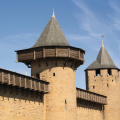CHÂTEAU COMTAL ET REMPARTS DE LA CITÉ DE CARCASSONNE
Take a tour of one of Europe's largest fortified towns! On the programme: the Château Comtal, its towers and ramparts.
The Cité de Carcassonne is a unique example of medieval military architecture. Not only is it one of the largest fortified towns in Europe, it is also the largest medieval complex on the continent, and undoubtedly one of the best preserved. The stones that make up the Cité tell us the story of the place. A rich and complex history, spanning several centuries, from Gallo-Roman times (as early as the 3rd century BC) to the 19th century. To stroll through the citadel and stand on its ramparts is to contemplate 2,500 years of history.
At the heart of the medieval city of Carcassonne, the highlight of the visit, the Château Comtal was built in the western part of the Cité, the highest and therefore best protected. On this flank, the Cité overlooks the Aude, making it difficult to access and thus playing a protective role. Today, the château is composed of a seigniorial palace separating two courtyards, and dominates the lower town, protected by 11 towers including 2 dungeons. The main entrance is guarded by twin towers forming a châtelet with elaborate defensive systems. The Watch Tower, in the Cour du Midi, is the castle's tallest tower. It is one of the few square towers in the town.
Constantly modified over time, the château comtal was enlarged in the 12th century by the Trencavel family, Viscounts of Carcassonne. A primitive castle had already stood on this site. The construction of this new palace, launched around 1130, took place in a very particular context. The establishment of the feudal system led to the division of territory and the decentralisation of power: vast territorial units were placed under the responsibility of lords, charged with administering the various regions on behalf of the Carolingian kingdom. Although these families owed allegiance to the king, they were increasingly powerful and independent. In Carcassonne, the Trencavel dynasty succeeded in establishing its dominance and took over management of the viscounty. They were an important family of fierce warriors and great builders. However, the city was threatened by the presence of two powerful neighbours, the Counts of Toulouse and Barcelona, who were fighting over the south of France. The Viscounts of Carcassonne, allying themselves with one or the other, managed to come to terms with these two powers.
It was a prosperous period, which saw the development of trade and the urban expansion of the Cité. After the construction of the Basilica of Saint-Nazaire, the castle, intended to house the lordly power, was fortified and enlarged. By the 11th century, it had become a major living space, with a great hall, kitchens, stables and keep. This is the only room in the château comtal to have retained its medieval appearance, and the walls of the ceremonial hall are still adorned with the original paintings. Made from semi-precious stones, they depict epic scenes recounting the power of the Lords during the Crusades. Later, in the 12th century, the château also housed a chapel dedicated to the Virgin Mary, which was destroyed during the French Revolution (with the exception of its apse, still visible). Today, little remains of the château from this period, which consisted of two L-shaped buildings dominated by a watchtower. The castle was separated from the rest of the town by a simple palisade.
It wasn't until the 13th century that the castle and its fortifications began to expand. The Trencavel reign came to an abrupt end with the Albigensian Crusade, proclaimed by the Catholic Church against Catharism. The viscounts were dispossessed of their lands. The Cité became part of the royal domain, and the seat of a seneschaussée, a high administrative, judicial and military place designed to represent the king's power in the region. This marked the beginning of a dark period, with the Inquisition setting up shop in the Cité, where a climate of mistrust reigned. It was at this time that the château took on its present form. The Kingdom of France wished to strengthen the citadel and protect it from attacks that could come from outside (notably from Spain), but also from within. The king wished to consolidate his power and domination over the local population, and commissioned military engineers to build fortifications around the castle, which took on the appearance of an impregnable fortress. Ditches were dug around the building to separate it from the inhabitants, and a barbican with a sentry walk was installed at the entrance. With its machicolation, portcullis and two towers, the entrance gate is virtually impenetrable. It was also during this period that the city acquired its second wall, encircling the first for 1.5 km.
Nearly destroyed after its abandonment, the Cité de Carcassonne today owes much of its authenticity to the restoration work initiated by the 19th-century architect Viollet-le-Duc. Begun in 1853, it was completed in 1911. Today, visitors can discover the château comtal, its ramparts and its lapidary museum on a self-guided or guided tour, and learn more about the history of the site through a film.
Did you know? This review was written by our professional authors.
The strengths of this establishment:
Members' reviews on CHÂTEAU COMTAL ET REMPARTS DE LA CITÉ DE CARCASSONNE
The ratings and reviews below reflect the subjective opinions of members and not the opinion of The Little Witty.







Veramente ben tenuto e con un fascino particolare.
Da vedere ????